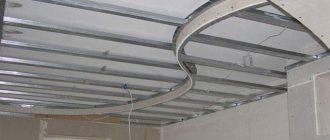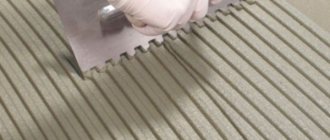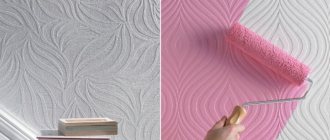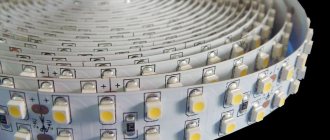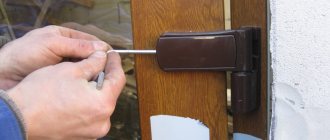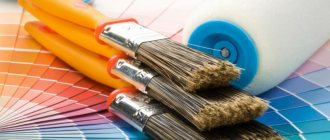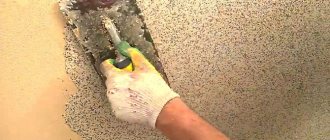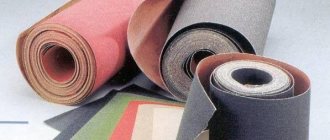When arranging a room, it is not at all necessary to purchase textured wallpaper with a pattern, since a beautiful image can be applied to the surface of a structural element, without even needing a stencil. A roller with a ready-made pattern for the walls is used especially for this purpose. This device has an already prepared image on the cylinder. Not everyone is familiar with such a tool, the procedure for selecting it, and the method of application, which is why we will dwell in more detail on this version of the device.
Classification
When choosing rollers for decorative plaster or painting, you need to take into account not only the finishing material you will have to work with. Manufacturers replenish their assortment with samples in various designs regarding composition, structure, and design. Let's take a closer look at the classifier of painting tools.
What is it made of?
Structurally, the device is identical to a classic paint roller. It consists of a curved base (metal or plastic rod), on which an ergonomic hollow handle is strung, and on the other side there is a removable or permanent attachment. The tool for stamping a pattern is distinguished by the presence of two cylinders: for paint and with a grooved surface.
Design stamping tool Source fillyourhomewithlove.com
Handles can be cast from different materials. As a rule, it is hard plastic or plastic. The first one is heavier, but more convenient to use. The second one is lighter, but can break if used carelessly. Often there is a discrepancy between the size of the tip of the telescopic handle.
Nozzles are distinguished by two characteristics: the material of the working shell or coat, textured design. Let's consider the types of nozzles according to the first criterion:
- Tree. Natural material has less adhesion to leveling mixtures, which simplifies the process of creating relief on the working base. Also, the nozzle weighs less and does not exhibit chemical reactivity with paints and solutions. The disadvantage is that the nozzle swells and cracks from direct contact with water. Therefore, you need to thoroughly clean the tool, wipe it and dry it after each working stage.
- Rubber. The material is characterized by high density, which is reflected in the total mass of the tool. To create a texture or pattern, the surface can be embossed and have indentations of different shapes. Working with plaster requires experience to ensure that the print is neat and distinct.
Rubber nozzle with textured surface Source kd.market
- Plastic. Such rollers for textured plaster can be considered a cheap alternative to rubber samples. There is instability to a number of mortars and paints. Over time, the textured shell deforms and cracks. Therefore, the device is more suitable for one-time repairs.
- Leather. Craftsmen achieve maximum quality with samples made from natural materials, which also last longer. As a rule, such nozzles are used to form a coating with a marble effect, which is especially important for applying Venetian plaster. The synthetic analogue wears out faster, but also allows you to perform the assigned tasks.
- Pile. Here, options made from acrylic and polyamide and natural fur are more often considered (faux fur quickly becomes unusable). The texture is determined by the length of the threads. A short pile leaves a less pronounced mark than an elongated one. When choosing such textured rollers for decorative plaster, you need to pay attention to the quality of fastening the threads. Cheap attachments "climb".
Less commonly used are decorative analogues with attachments that are covered with fabric, made of polystyrene foam or foam rubber.
Structural foam roller Source sdelai-lestnicu.ru
This is due to the short service life of the nozzles. Most samples are used to create a continuous coating with a simple texture. For example, bubbles, jagged lines, uneven craters.
See also: Catalog of companies that specialize in paints and varnishes and related work
Physical execution
The size range is presented in three conditional groups. Mini rollers are limited to a length of 150 mm. They are used for decorating narrow areas. Midi are in great demand for decoration inside the building. Here the length of the roller is 150-250 mm, the diameter reaches 90 mm. The maxi group is made of durable materials that are chemically inert to most building materials. Such tools are convenient for working with large areas.
Based on the type of surface, there are two types of rollers: textured and structural. The table shows examples of nozzles and coatings that can be created with them.
| Roller type | Result | Recommendations | |
| Textured rollers | |||
| Long pile | Fur coat | A better effect can be achieved with wide nozzles, as fewer intersections are formed. A surface with indentations leaves protruding marks and vice versa. It is better to make an impression on plaster that has begun to set. This way the solution will drag less behind the texture roller, and the pressed marks will be clearer. | |
| Loop pattern (“ears”) | A natural stone | ||
| Leather, fabric | Marble | ||
| Structural rollers | |||
| Wooden or rubber roller | Repeating or closed pattern | To create texture on the leveling solution, it is worth considering rollers with a slightly pronounced relief. You can work only 20-30 minutes after applying the solution. In order for the result to be continuous, the actions are performed with equally little effort, rolling the roller as close as possible to the previous mark. | |
More often, with a structural roller, work is performed on an already prepared, flat surface. The drawing is applied using paint. Plaster and putty here will clog the cavities, which leads to a distortion of the desired result.
How to make a roller yourself
The range of ready-made videos is wide, but in a particular retail outlet, as a rule, it is very limited. Therefore, it is often necessary to solve the problem of choice by independently making a figured roller with the desired texture. The table discusses several possible options for solving a particular design problem:
| Result | Solution |
| Wood fiber imitation | The basis is a rubber roller with a smooth surface. You can use a tool to smooth out wallpaper, preferably one made of hard material (for example, gray from Knauf). A tourniquet is wound onto the roller with a slight degree of randomness. To ensure that the threads last longer and remain clean, you should use a rubber band and additionally fix it to the base using waterproof glue. An alternative is a plastic roller and strips of thick fabric. |
| Woven pattern | Fabric with a pronounced texture is wound and glued onto a rigid roller. These can be samples with dense, coarse threads or with relatively sparse weave. |
| Torn drawing, abstraction | Here, on any type of roller for decorative painting of walls, you can randomly wrap a rope, fabric, leather, rope, or polyethylene. In this case, paint is applied or an impression is formed with different forces. The direction of the strokes is also freely chosen. |
| Accurate drawing | As a rule, a geometric pattern is implied here. You can cut it out on a foam roller. If a more complex result is needed, then it is burned onto the workpiece. |
In addition to rollers, you can use other tools to create various surfaces or do without them at all. So, if you apply plaster with a higher water content to the base, you will get an aged coating with a web of cracks. The same effect will be achieved with putty if you apply the liquid composition in a thick layer.
Chaotic compositions can be obtained with the additional use of brushes, trowels, and spatulas. Here, small strokes are first applied, then one or another texture is formed with a decorative roller for the walls. More complex results are obtained after preliminary sketching using available tools.
Pattern application technique
To achieve an optimal result, you must follow the correct technique for applying a pattern to the surface of a structural element, namely:
- First, you need to determine for yourself a plan for carrying out the work (you should start from the corner of the room).
- The dye is poured (in the required amount) into a special container convenient for painting.
- While immersing the roller in the paint, it is necessary to evenly distribute the dye over the entire area of the nozzle.
- When applying paint and varnish to a wall, you should control the force so that smudges are not created.
- When performing work, a second coat should be applied only after the previous one has completely dried.
- The area to be painted should be observed so that there are no unpainted areas left.
- The dye must be applied evenly to the entire surface, starting from the bottom of the structural element.
Experts recommend painting the wall not strictly vertically, but moving the roller slightly diagonally. This will allow you to achieve better proportions and transfer the image as accurately as possible.
Important! To avoid serious mistakes, it is recommended to do a little practice beforehand.
At the moment, there is no need to purchase expensive textured wallpaper, since it is possible to create an image using ordinary paint. In such a situation, you will need to use a special decorative roller. This allows you to significantly improve the interior of the room, while significantly saving on the purchase of material. Of course, there is a risk of encountering difficulties, but with proper preparation and work, they can be completely eliminated.
Execution of work
To obtain a uniform result, a flat surface is a prerequisite. This will create a texture with identical depth, and the paint will be applied in the same layer. Also, the seam from the edge of the roller will not stand out on the plane.
Preparing the base
The behavior of the decorative coating depends on the condition of the surface. Thus, cracks and looseness lead to a rapid spread of similar consequences to the finish.
A common defect that needs to be fixed Source pixabay.com
The same applies to rust, fungal formations, and some oily substances. As a result, before applying decorative plaster or a pattern with a roller, it is important to eliminate any damage, contamination, or defects in the base.
After strengthening and cleaning the base, preventive treatment and continuous priming are carried out. The last action is aimed at removing dust from the surface, strengthening it, and improving adhesion between different materials. That is, among other things, peeling of plaster or paint from the working surface is prevented.
Decorative plastering
The work is performed on a flat surface after priming and drying the surface. The entire event includes several activities. First you need to prepare a homogeneous solution in accordance with the recommended recipe from the manufacturer. The following is done:
- a uniform coating of 2-4 mm is formed using a spatula (width 300-600 mm);
- after distributing and smoothing the solution, wait 10-30 minutes for the composition to begin to set (gypsum faster, cement longer);
- An impression is formed with a textured roller in one pass without strong pressure in the direction from bottom to top.
Creating a pattern using a short-haired nozzle Source amazonaws.com
Another option is to apply decorative plaster with a roller. Here the task is performed with a working solution. The texture is created without clear forms.
Some craftsmen perform the last step from the ceiling to the floor. But there is a risk of the mortar lingering behind the roller settling due to its own weight. If you work upward, the mixture returns to its original position, and the small protrusion can be sanded down.
Features of using a stencil roller
If you want to decorate the interior of a room with drawings applied to the wall using a textured roller, it is recommended to take into account the following nuances:
- The stencil tool can only be used when applying the final coat of paint.
- It is necessary to choose the colors correctly so that the last spraying does not show through the previous texture.
- It is imperative to carefully prepare the structural element for the upcoming final finishing.
- If a textured mechanism with a pattern is used, paint should be applied to the wall correctly, without corresponding gaps or overlaps.
- For decoration, you will have to choose the right type of cylinder (the material from which the attachment of the device is made).
- This type of arrangement can only be used in places where there are no hard-to-reach surfaces.
A decorative roller and applied paint and varnish material can easily replace wallpaper, however, it is recommended to practice first in order to subsequently avoid mistakes during work.
Important! Before carrying out the appropriate measures, you need to choose the right paint, and also the material of the nozzle, since not all types of elements are suitable for this purpose.
Briefly about the main thing
A structural roller for decorative plaster consists of a rod, a nozzle and a handle.
To apply a design with paint, it is possible to attach a second nozzle.
Ready-to-use tools are made of rubber, plastic, wood, and foam rubber.
You can make the device yourself from a simple roller and scrap materials.
The decorative surface is created by applying a design or forming impressions and projections on the plastered surface.
Ratings 0
Using a homemade tool
In order to make a textured roller, you need to tie or glue pieces of foam rubber, fabric or cellophane onto a regular one. After completing this procedure, you can use such a roller to apply a water-based composition to the surface of a wall or ceiling. This decor option will look very original and aesthetically pleasing. You can also use wire wound on a roller.
How to apply decorative plaster fur coat
One of the common finishing options using decorative plaster is “fur coat”. You can create such a lining yourself using a fur roller. First of all you need to do:
- surface preparation;
- mixing plaster mortar;
- tinting the mixture.
The application process itself is not complicated. It is necessary to dip the roller into the plaster and move it across the surface. This can be done both vertically and horizontally, the main thing is to always move in one direction. In this case, transitions and stripes will not be highlighted.
To get the expected result when using the “fur coat” technology, you need to take a responsible approach to choosing a roller, since the result will depend on it. A tool with long, thick bristles will allow you to create a coarser pattern, while thin bristles will make it possible to obtain a more delicate surface.
The main rule is to use rollers with medium or long hair, since devices with short hair will not give the desired effect.
How to make a textured coating with your own hands?
Many citizens want to save on coating costs and try to make textured paint themselves using scrap materials. In order for the composition to be of good quality, you need to correctly observe the proportions of the ingredients and follow the step-by-step instructions:
- You need to buy acrylic paint.
- You need to add sawdust and granite chips to it. Quartz sand is also required.
- The mixture needs to be stirred. The number of constituent elements will depend on where the paint will be used. The composition for the facade will be different from the composition for interior decoration.
What are the advantages of textured paint?
Textured paint has a number of advantages over other surfaces:
- It can mask various defects on the wall. To obtain the desired effect, it is not necessary to putty the surface.
- The result is a uniform coating, without joints or seams.
- You can do the work yourself.
- Saving money that a person would have spent on paying for specialist services.
- Opportunity to create a unique room design.
- The coating can be used in a children's room, as the textured paint is resistant to mechanical damage.
- Increased moisture resistance of paint.
- Environmentally friendly product composition. The paint is not dangerous to human health and life.
Description of material
Paint for relief painting of walls is a thick solution. It is very viscous. The coating is based on an acrylic binder. Options for mineral binders, as well as silicone, are possible. They contain certain fillers that are responsible for the texture of the wall. Textured enamel is easy to apply, the process will not take much time even for a beginner.
You can choose white paint or colored paint. If a person prefers a mineral composition, then it is better to buy a dry mixture. To prepare the solution, it must be diluted with water. This type of coating is ideal for working on facades.
Many people do their own relief painting of walls using water-based paint. This type of coating can be purchased in white and tinted with your favorite pigment yourself. The result is a wall covering that resembles decorative plaster.
What types of fillers are there and what sizes?
To make the paint thicker and create a relief, special particles are added to it. Regardless of what type of structural paint was chosen for the walls, there is always one advantage - good water resistance.
The following types with fillers are distinguished:
- Marble chips. Granite looks no less impressive.
- Fine gas silicate is popular these days.
- Quartz sand is suitable for many interiors.
- Metal particles that reflect light will decorate the walls of living rooms.
- Sawdust or shavings.
- Natural fibers. Synthetic ones are also used to cover walls.
Manufacturers use various thickeners. Some add a special type of starch and pigments. The result is the effect of silk walls that shine with mother-of-pearl.
Particle shapes also vary. They can be in the form of scales or drops. The depth of the relief will be determined by the size of the particles.
Relief paints for walls are:
- Fine-grained. Their filler diameter is 0.5 millimeters.
- Medium grain. They have a filler diameter from 0.5 millimeter to 1 millimeter.
- Coarse-grained. They have particles with a diameter of 1 to 2 millimeters.
What are the disadvantages of textured paint?
In addition to the advantages, this coating has its disadvantages. If people want to do a different type of wall covering, they will have to completely remove the embossed paint. This process will take a lot of time and effort. You cannot put wallpaper on a surface without removing the paint layer.
During operation, a large amount of material is consumed. A minimum of six hundred grams of paint is required per square meter. This value can increase to two kilograms, depending on the room. The cost of finishing is increasing all the time.
